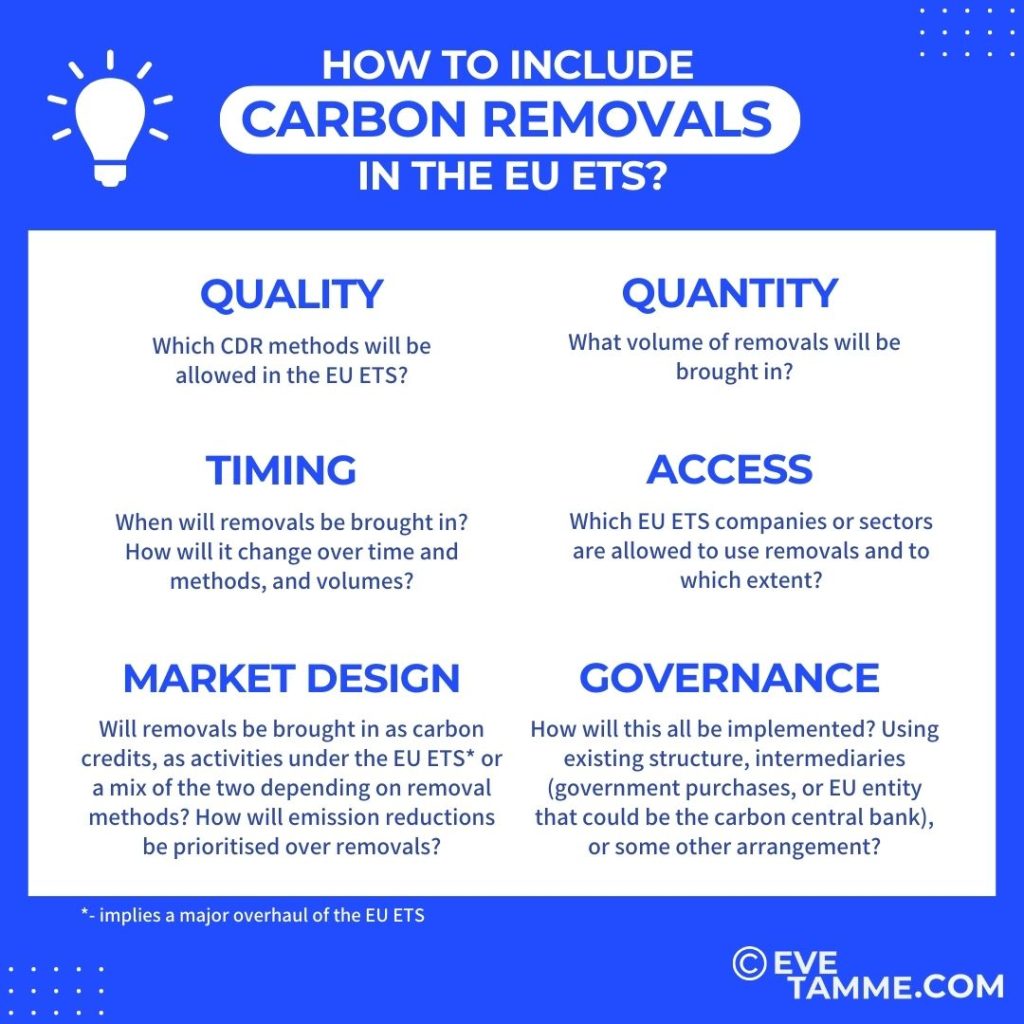What are the key considerations around including carbon dioxide removal in the EU Emissions Trading System (EU ETS)? Compared to a couple of years ago, the conversations have evolved from whether to bring in removals to how to do it in practice.
I first wrote about this topic a year and a half ago. Discussions have moved on since then, and it’s time for an update. We now have a revised EU ETS, which is designed to arrive at zero emissions by 2039. That is only 16 years away.
Lately, the conversations around removals and the EU ETS have focused quite a bit on the governance aspects, but that is only one piece of the puzzle. Policymakers need to establish several key principles upfront and provide the market with the predictability it needs. I’ve divided the main questions arbitrarily into six areas of consideration. Let’s walk through these one by one.

Quality
Which Carbon Dioxide Removal (CDR) methods will be included? The word “quality” here would imply high-quality removals.
Given that the EU ETS covers industrial and fossil emissions, the inclusion of the most durable removal methods that have low uncertainty in carbon accounting and monitoring, reporting and verification (MRV) are most likely to be considered. This would guarantee a “like for like” approach where fossil emissions are balanced with durable removals. In the context of the EU ETS, the inclusion of Direct Air Carbon Capture and Storage (DACCS) and Bioenergy with Carbon Capture and Storage (BECCS) are mentioned most often.
There is a well-established firewall between the land use, land use change and forestry (LULUCF) sector and the EU ETS. Traditional land-based removals (afforestation, reforestation, soil carbon sequestration) are not linked with the EU ETS through the flexibility mechanisms. Because of this, it’s highly unlikely that carbon farming would play a role under the EU ETS. Furthermore, the European Commission is considering including such removals under the agricultural emissions trading system.
However, the UK is considering going beyond “like for like” and bringing in land-based removals into the UK ETS.
Quantity
What volume of removals will be brought in? What is the right volume? Should it be informed by the expected level of residual emission or other aspects? Where national or corporate net-zero targets are discussed, the optimal share of emission reductions versus removals tends to lie between 90%-10% to 80%-20%. Will there be a similar calculation for the net zero point in the EU ETS?
Will there be limitations on volume per removal method? If yes, how will this change over time?
Timing
From when will removals be let in the EU ETS? How will this change over time, and removal methods?
We are likely to see a phased approach where durable removal methods with higher technology readiness levels (TRL) are allowed in first, and others may follow as they climb up the TRL ladder and get uncertainties in carbon accounting and MRV addressed.
Given that the emissions in the EU ETS are supposed to zero in 2039, does that imply that this could be the net-zero moment for the EU ETS if removals are brought in?
Market design
How will the removal activities be brought in? This has strong implications around how emission reductions will be prioritised, discussions around cap setting (the EU ETS is a cap-and-trade system) and more. The EU ETS has taken close to two decades to become the best-performing emissions trading system globally. How do we bring in removals in a way that doesn’t undermine its integrity?
There are three ways of including removals from the structural perspective:
a) As part of the EU ETS scope
This would require fundamental changes to the foundations of the EU ETS. An emissions trading system would need to be redesigned into an emissions and removals trading system.
b) As carbon credits or certificates
Carbon credits under the Kyoto Protocol (CERs and ERUs) were used in the EU ETS for a while. The memory of this is painful, given that it created years of oversupply in the system, contributing to a very low carbon price in the EU ETS in the past.
From which EU policy pillars will these credits come? Today, many novel carbon removal methods are outside the scope of the EU’s climate targets, but that is bound to change with the upcoming 2040 climate target. If these activities are not under the EU ETS, does it mean removals will be divided under the Effort Sharing Regulation (ESR) and the LULUCF regulation? Or will there be a fourth dedicated climate policy pillar for removals from which credits, certificates or other units (similarly as we have AEAs under the ESR) could be allowed into the EU ETS? Or will the main way forward be using the certificates from the Carbon Removal Certification Framework that currently includes removal activities inside and outside the EU’s climate targets?
For those who would like to understand the difference between carbon allowances and carbon credits, Table 1 in this post offers some clarity.
c) As a mix of a) and b)
Policymakers can also mix and match options a) and b), for example, including DACCS and BECCS within the scope and allowing other removal methods in as credits or certificates.
(“Market Design” is not an ideal title for the section, given that it can cover many other types of considerations. Feel free to share your thoughts on what would be a better fit.)
Access
Which EU ETS companies and sectors have access to removals and can use these for compliance? To what extent? Whether and how does it differ among sectors or companies?
The EU ETS is supposed to lead to zero emissions by 2039, but in practice, that is not possible. There will still be residual emissions that can’t be reduced. Be it because of a lack of technology (or its scale), price, political choices or societal considerations.
Which sectors and companies will be allowed to have residual emissions? What amount of residual emissions will be acceptable? Whether and how will access to removals be matched with sectors and companies that have residual emissions? There is a long list of complex considerations around these elements.
Governance
How will it all be implemented in practice? It’s important to have clarity on the other principles before digging deep into the governance aspects. But getting the governance right is equally important.
There is a wide range of ideas circulating, from the role of the governments as intermediaries for purchasing removals to establishing a European Carbon Central Bank. We are bound to see more ideas come forward over the next few years.
Final words
Including removals in the EU ETS consists of several complex decisions that will have to be made transparently, and enough in advance to offer policy predictability for stakeholders.
By July 2026, the European Commission will be issuing a report on how to include removals in the EU ETS whilst safeguarding emission reductions that the system is designed to deliver. In the years leading up to that, the stakeholders have an opportunity to explore the key principles and concepts, come up with well-designed solutions, and inform the policymakers in advance.
***
Thank you for reading! Sign up for updates below, and stay tuned for the next posts.
Would you like to use (parts of) the text? Go ahead on the condition that you explicitly refer to this post and include a link.
Thank you!

